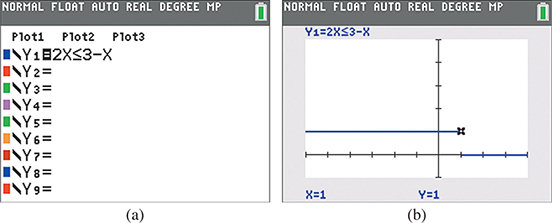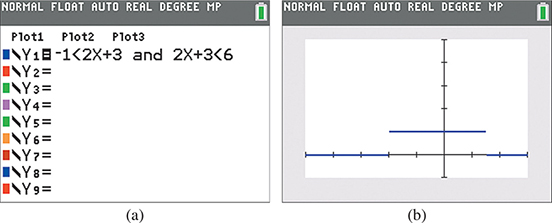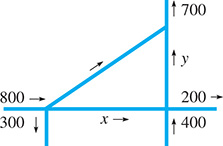17.2 Solving Linear Inequalities
Linear Inequalities • Inequalities with Three Members • Solving an Inequality with a Calculator
Using the properties and definitions discussed in Section 17.1, we can now proceed to solve inequalities. In this section, we solve linear inequalities in one variable. Similar to linear functions as defined in Chapter 5, a linear inequality is one in which each term contains only one variable and the exponent of each variable is 1. We will consider linear inequalities in two variables in Section 17.5.
The procedure for solving a linear inequality in one variable is similar to what we used in solving basic equations in Chapter 1. We solve the inequality by isolating the variable, and to do this we perform the same operations on each member of the inequality. The operations are based on the properties given in Section 17.1.
EXAMPLE 1 Solutions using basic operations
In each of the following inequalities, by performing the indicated operation, we isolate x and thereby solve the inequality.
Each solution can be checked by substituting any number in the indicated interval into the original inequality. For example, any value less than 2 will satisfy the first inequality, whereas any number greater than 8 will satisfy the second inequality.
EXAMPLE 2 Solving a linear inequality
Solve the following inequality:
We have the following solution:
CAUTION
Again, carefully note that the sign of inequality was reversed when each number was divided by
We check the solution by substituting in the original inequality, obtaining
EXAMPLE 3 Solving a linear inequality
Solve the inequality
The solution proceeds as follows:
This solution checks and is represented in Fig. 17.7, as we showed in Section 17.1.
This inequality could have been solved by combining x-terms on the right. In doing so, we would obtain Because this might be misread, it is best to combine the variable terms on the left, as we did above.

Fig. 17.7
EXAMPLE 4 Solving a linear inequality
Solve the inequality

Note that the sense of the inequality was reversed when we divided by This solution is shown in Fig. 17.8. Any value of checks when substituted into the original inequality.

Fig. 17.8
The following example illustrates an application that involves the solution of an inequality.
EXAMPLE 5 Linear inequality—missile velocity
The velocity v (in ft/s) of a missile in terms of the time t (in s) is given by For how long is the velocity positive? (Because velocity is a vector, this can also be interpreted as asking “how long is the missile moving upward?”)
In terms of inequalities, we are asked to find the values of t for which This means that we must solve the inequality The solution is as follows:
Negative values of t have no meaning in this problem. Checking we find that Therefore, the complete solution is
In Fig. 17.9(a), we show the graph of and in Fig. 17.9(b), we show the solution on the number line (which is really the t-axis in this case). Note that the values of v are above the t-axis for those values of t that are part of the solution. This shows the relationship of the graph of v as a function of t, and the solution as graphed on the number line (the t-axis).

Fig. 17.9
INEQUALITIES WITH THREE MEMBERS
EXAMPLE 6 Solving inequality with three members
Solve:
We have the following solution.
The solution is shown in Fig. 17.10.

Fig. 17.10
EXAMPLE 7 Solving inequality with three members
Solve the inequality
Since we cannot isolate x in the middle member (or in any member), we rewrite the inequality as
We then solve each of the inequalities, keeping in mind that the solution must satisfy both of them. Therefore, we have
We see that the solution is and which can also be written as This second form is generally preferred since it is more concise and more easily interpreted. The solution checks and is shown in Fig. 17.11.

Fig. 17.11
EXAMPLE 8 Inequality with three members—pump rates
In emptying a wastewater tank, one pump can remove no more than 40 L/min. If it operates for 8.0 min and a second pump operates for 5.0 min, what must be the pumping rate of the second pump if 480 L are to be removed?
Let pumping rate of the first pump and pumping rate of the second pump. Because the first operates for 8.0 min and the second for 5.0 min to remove 480 L, we have
Because we know that the first pump can remove no more than 40 L/min, which means that , we solve for x and then substitute in this inequality:
This means that the second pump must be able to pump at least 32 L/min and no more than 96 L/min. See Fig. 17.12.

Fig. 17.12
Although this was a three-member inequality combined with equalities, the solution was done in the same way as with a two-member inequality.
SOLVING AN INEQUALITY WITH A CALCULATOR
A calculator can be used to show the solution of an inequality. On most calculators, a value of 1 is shown if the inequality is satisfied, and a value of 0 is shown if the inequality is not satisfied. This means that if, for example, we enter (see the manual to see how is entered), the calculator displays 1, and if we enter it shows 0, as in the display in Fig. 17.13. We can also use an inequality feature to show graphically the solution of an inequality.

Fig. 17.13
EXAMPLE 9 Inequality solution on calculator
Display the solution of the inequality (see Example 3) on a calculator.
We set equal to the inequality, as shown in Fig. 17.14(a) and then graph From Fig. 17.14(b), we see that up to Using the value feature, we can also see that right at This means the inequality is satisfied for all values of x less than or equal to 1. Thus, the solution set is Compare Fig. 17.14(b) with Fig. 17.7.

Fig. 17.14
EXAMPLE 10 Inequality solution on calculator
Display the solution of the inequality (see Example 6) on a calculator.
In order to display the solution, we must write the inequality as
Then enter and (consult the manual to determine how “and” is entered) in the calculator, as shown in Fig. 17.15(a). From Fig. 17.15(b), we see that the solution is The trace and zoom features can be used to get accurate values. Compare Fig. 17.15(b) with Fig. 17.10.

Fig. 17.15
EXERCISES 17.2
In Exercises 1–4, make the given changes in the indicated examples of this section and then perform the indicated operations.
In Example 2, change 3 to 25 and solve the resulting inequality.
In Example 4, change the 1/4 to 7/4 and then solve and display the resulting inequality.
In Example 6, change the in the middle member to and then solve the resulting inequality. Graph the solution.
In Example 10, change the in the middle member to and then display the solution on a graphing calculator.
In Exercises 5–28, solve the given inequalities. Graph each solution.
or
In Exercises 29–38, solve the inequalities by displaying the solutions on a calculator. See Examples 9 and 10.
In Exercises 39–60, solve the given problems by setting up and solving appropriate inequalities. Graph each solution.
Determine the values of x that are in the domain of the function
Determine the values of x that are in the domain of the function
For what values of k are the roots of the equation imaginary?
For what values of k are the roots of the equation real and unequal?
For find a and b if
For find a and b such that
Insert the proper sign for the ? such that is true.
Insert the proper sign for the ? such that is true.
What range of annual interest I will give between $240 and $360 annual income from an investment of $7500?
Parking at an airport costs $3.00 for the first hour, or any part thereof, and $2.50 for each additional hour, or any part thereof. What range of hours costs at least $28 and no more than $78?
A contractor is considering two similar jobs, each of which is estimated to take n hours to complete. One pays $350 plus $15 per hour, and the other pays $25 per hour. For what values of n will the contractor make more at the second position?
In designing plastic pipe, if the inner radius r is increased by 5.00 cm, and the inner cross-sectional area is increased by between and what are the possible inner radii of the pipe?
The relation between the temperature in degrees Fahrenheit F and degrees Celsius C is What temperatures F correspond to temperatures between 10°C and 20°C?
The voltage drop V across a resistor is the product of the current i (in A) and the resistance R (in ). Find the possible voltage drops across a variable resistor R, if the minimum and maximum resistances are and respectively, and the current is constant at 2.5 mA.
A rectangular PV (photovoltaic) solar panel is designed to be 1.42 m long and supply of power. What must the width of the panel be in order to supply between 100 W and 150 W?
A beam is supported at each end, as shown in Fig. 17.16. Analyzing the forces leads to the equation For what values of d is more than 6 N?

Fig. 17.16
The mass m (in g) of silver plate on a dish is increased by electroplating. The mass of silver on the plate is given by where t is the time (in h) of electroplating. For what values of t is m between 131 g and 164 g?
For a ground temperature of (in °C), the temperature T (in° C) at a height h (in m) above the ground is given approximately by If the ground temperature is 25°C, for what heights is the temperature above 10°C?
During a given rush hour, the numbers of vehicles shown in Fig. 17.17 go in the indicated directions in a one-way-street section of a city. By finding the possible values of x and the equation relating x and y, find the possible values of y.

Fig. 17.17
The minimum legal speed on a certain interstate highway is 45 mi/h, and the maximum legal speed is 65 mi/h. What legal distances can a motorist travel in 4 h on this highway without stopping?
The route of a rapid transit train is 40 km long, and the train makes five stops of equal length. If the train is actually moving for 1 h and each stop must be at least 2 min, what are the lengths of the stops if the train maintains an average speed of at least 30 km/h, including stop times?
An oil company plans to install eight storage tanks, each with a capacity of x liters, and five additional tanks, each with a capacity of y liters, such that the total capacity of all tanks is 440,000 L. If capacity y will be at least 40,000 L, what are the possible values of capacity x?
